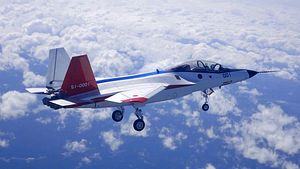Japan’s Ministry of Defense (MoD) denied reports that it has abandoned plans to indigenously develop a fifth-generation stealth fighter and is leaning toward a joint development of a fighter aircraft with an international manufacturer, a MoD source told IHS Jane’s Defense Weekly on March 6.
“A source in the MoD told Jane’s that program officials have not made any decisions and that several streams of development are still being evaluated,” IHS Jane’s reports. “These include licensed production of an existing foreign design, joint development of a new aircraft with an international manufacturer, the development of an indigenous platform, or a program to upgrade and refurbish the F-2.”
This has been the standard line of MoD officials since the inception of the program. As I reported yesterday, there is strong indication that the Ministry of Defense will not seek funds for its Acquisition Technology & Logistics Agency (ATLA) to continue work on Mitsubishi Heavy Industries’ experimental fifth-generation fighter technology demonstrator X-2 “Shinshin” (formerly the ATD-X). The X-2 prototype was to serve as the basis for the development of the F-3, Japan’s first indigenously designed fifth-generation stealth fighter jet.
The reasons for the purported cancellation of the program are high R&D costs and the lack of viable and cost-effective domestic fifth-generation aircraft technologies for the X-2, including developing a next-generation aircraft engine featuring a 3D thrust vectoring capability. It is still more than likely that Japan will collaborate with the U.S. defense industry and other international partners to develop a next-generation stealth fighter jet as most existing international designs (e.g., the F-35A and B) do not fulfill all of Japan’s operational requirements.
As I noted yesterday:
Japan originally intended to procure Lockheed Martin’s F-22 Raptor, but the U.S. government refused an export license, forcing Japan to initiate its own stealth fighter jet program in the 2000s. The Japanese MoD plans to induct up to 100 fifth-generation fighter jets by the 2030s. A contract, estimated to be worth over $20 billion, was initially expected to be awarded this summer, but there has been no official progress report on the tender so far in 2018 and the decision will most likely be postponed.
A collaborative new aircraft design, perhaps in partnership with Lockheed Martin, would most likely be based on the F-22 but larger. Japan wants its new multirole fighter jets to be capable of engaging in anti-surface war over long distances and consequently to be capable of carrying long-range, supersonic anti-ship missiles in an internal bay. Japan is also likely to place an additional order for up to 25 F-35A stealth fighters from Lockheed Martin. These aircraft are expected to be armed with the next-generation, long-range, precision-guided Joint Strike Missile (JSM) or the U.S.-made Joint Air to Surface Standoff Missile (JASSM).
































